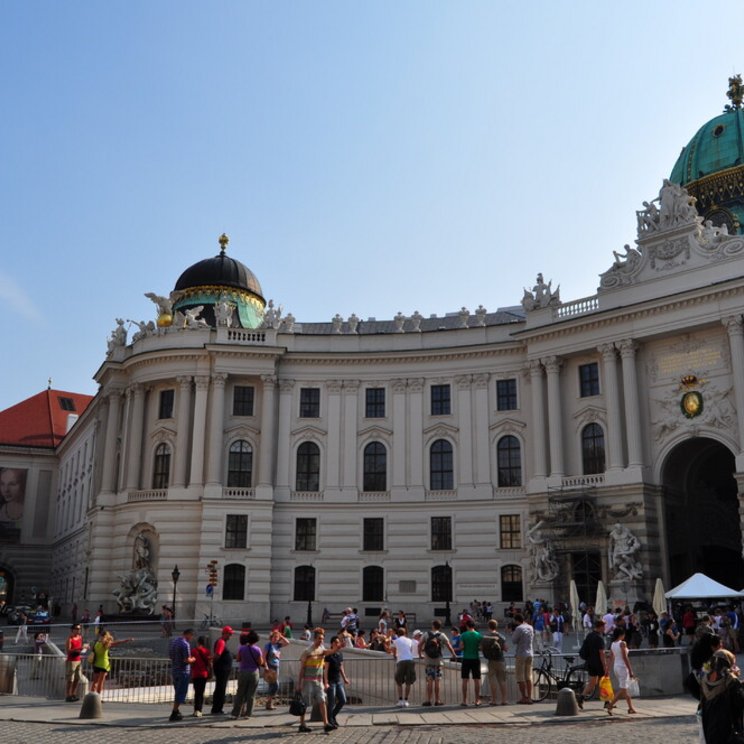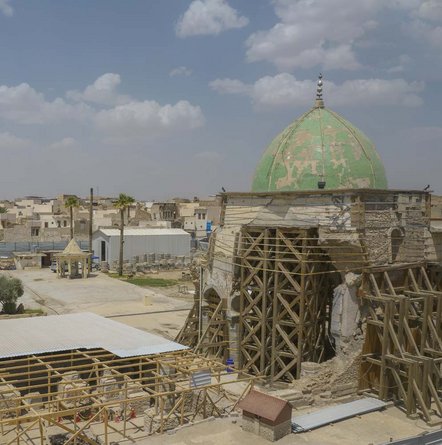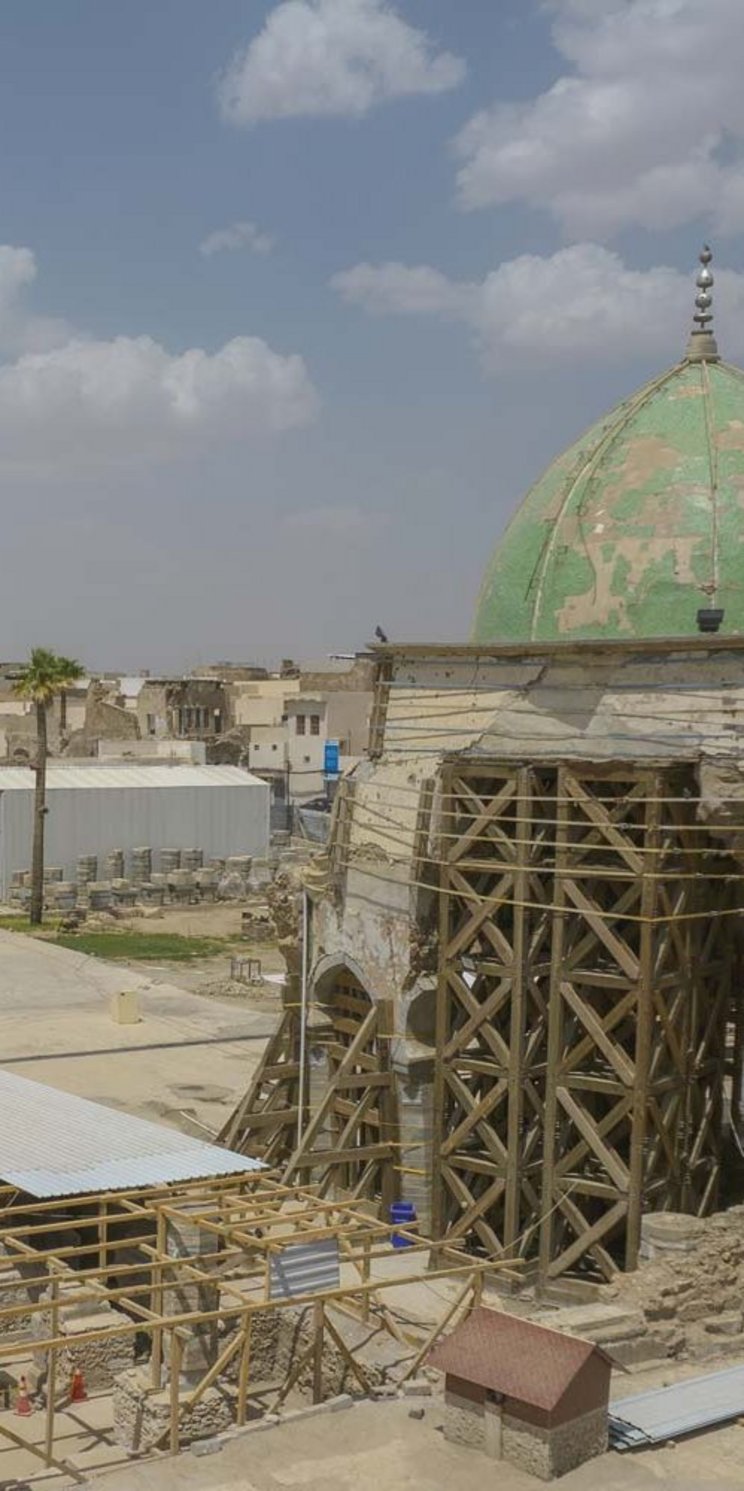

Zerstörung von kulturellen Stätten und Gütern
Kulturgüter und -stätten sind Teil des kulturellen Erbes der Menschheit. Sei sind Träger von jahrhundertealtem Wissen, von Traditionen und Geschichte, von Praktiken, Lebensformen und Identitäten. Sie für die zukünftigen Generationen zu erhalten und zu bewahren, ist daher unerlässlich. Die UNESCO setzt sich seither für den Schutz von Kulturgütern und Kulturstätten ein.
Materielles Kulturgut umfasst bewegliche wie unbewegliche Objekte. Archivalien oder Kunstgüter etwa in Museen oder Bibliotheken gehören ebenso dazu wie archäologische und baugeschichtliche Stätten oder historische Gärten und Parks. Gleich, ob zu Land oder unter Wasser können diese Kulturgüter durch Naturkatastrophen beschädigt oder zerstört werden oder sie sind in Krisenregionen - willentlich oder unwillentlich - Ziel von bewaffneten Konflikten oder Terrorismus. Manchmal sind diese Stätten Teil des Welterbes der UNESCO. Wie dringlich Kulturgutschutz ist, zeigen die jüngeren Zerstörungen an Welterbestätten in der Ukraine, Syrien, Gaza oder Timbuktu (Mali) in 2014.
Illegaler Handel mit Kulturgütern
Eine weitere Herausforderung neben der Zerstörung von Kulturstätten ist der illegale Handel mit beweglichen Kunst- und Kulturgegenständen und Antiquitäten. In Konfliktgebieten können Plünderungen von Museen oder archäologischen Grabungsstätten und Schmuggel von Kulturgütern zugleich der Finanzierung von kriegerischen und terroristischen Aktivitäten dienen. Auch in der EU müssen Kulturgüter vor illegaler Aus- und Einfuhr geschützt werden.

Internationaler Schutz von Kulturgütern
Durch die Beschädigung, Zerstörung oder den Diebstahl wertvoller Kulturgüter und -stätten wird eine wesentliche Grundlagen für den Frieden entzogen. Denn Kulturgüter und -stätten haben eine wichtige Symbol- und Vermittlungsfunktion, mit der sie zur Völkerverständigung beitragen. Sie festigen soziale Identitäten und Kulturen, und sind Zeugnisse menschlichen Erbes und Entwicklung. Ihr Schutz kommt daher stets der Allgemeinheit zugute. Aus diesem Grund haben die UNESCO und viele Staaten nationale und internationale Maßnahmen für den Kulturgutschutz ergriffen. Kulturgutschutz ist zudem in zahlreichen Ländern eine wichtige Aufgabe der Kulturpolitik.
Ausgangspunkt für alle nationalen und internationalen Vorschriften für den Schutz von Kulturgütern ist die „Haager KonventionExterner Link:“ von 1954. Sie ist das älteste völkerrechtlich bindende Abkommen zum Schutz von Kulturgut. Die Konvention soll bewegliche und unbewegliche Kulturgüter vor Zerstörung, Plünderung und Diebstahl in Kriegen und bewaffneten Konflikten bewahren. Zwei Protokolle von 1954 und 1999Externer Link: ergänzen und präzisieren die Konvention. Entstanden ist die Haager Konvention vor dem Hintergrund des Ersten und Zweiten Weltkrieges unter Federführung der Vereinten Nationen. Für die Überwachung ihrer Einhaltung ist die UNESCO zuständig. Sie wurde bereits von mehr als 130 Staaten unterzeichnet, darunter auch von der Bundesrepublik Deutschland im Jahr 1967. Zuständig für die Durchführung der Maßnahmen nach der Haager Konvention in Deutschland ist das Bundesamt für Bevölkerungsschutz und Katastrophenhilfe (BBK)Externer Link:.
70 Jahre Haager Konvention 2024
Gemeinsame Pressemitteilung von Blue Shield Deutschland und der Deutschen UNESCO-Kommission, 13. Mai 2024
LesenEin weiteres wichtiges völkerrechtliches Instrument zur Bekämpfung des illegalen Handels mit Kulturgut ist das UNESCO-Übereinkommen über Maßnahmen zum Verbot und zur Verhütung der unzulässigen Einfuhr, Ausfuhr und Übereignung von KulturgutExterner Link: von 1970. Die Konvention soll den illegalen Handel mit beweglichen Kulturgütern verhindern und sieht für den Fall der unrechtmäßigen Verbringung von Kulturgut einen Rückgabeanspruch vor.
Eines der erfolgreichsten internationalen Schutzinstrumente für Natur- und Kulturerbe weltweit ist die UNESCO-Welterbekonvention. Sie basiert auf dem Prinzip der internationalen Solidarität und Zusammenarbeit zum Schutz von Kultur- und Naturstätten, die von außergewöhnlichem universellem Wert sind. mehr lesen
Darüber hinaus gibt es weitere Bestimmungen und Maßnahmen auf nationaler und internationaler Ebene, wie den EU-Aktionsplan zur Bekämpfung des illegalen Handels mit KulturgüternExterner Link: von 2022, die den illegalen Handel mit Kulturgütern und deren Rückführung regeln.
Kulturgutschutz in Deutschland
Der Klimawandel und seine Folgen, wie Hochwasser und andere Extrem-wetterereignisse stellen für bewegliche und unbewegliche Kulturgüter eine immer größere Gefährdung auch hierzulande dar. Historisch und kulturell relevante Dokumente oder Filme aber auch Baumaterialien sind durch materielle Alterung bedroht. Schadstoffe, Diebstahl oder Gewalttaten sind weitere potenzielle Risiken für Kultureinrichtungen wie Museen, Bibliotheken, Archive und ihre Bestände aber auch für historische und archäologische Stätten.
Der Schutz und die Bewahrung von Kulturgut in einem etwas enger gefassten Rechtsverständnis (z. B. Gemälde, Bücher, Handschriften oder archäologische Gegenstände) sind in Deutschland von hoher Priorität und Teil des Zivil- und KatastrophenschutzesExterner Link:. Gemeinschaftlich setzen sich Bund und Länder daher für den Kulturgutschutz ein.
Aufgabe der Bundesländer ist in erster Linie die Erhaltung von national wertvollem Kulturgut. Der Bund übernimmt wiederrum die zentrale Rolle bei der Gesetzgebung; einerseits für den Schutz von Kulturgut vor Abwanderung ins Ausland (nationaler Kulturgutschutz), andererseits für den Schutz von Kulturgütern ausländischer Staaten, die unrechtmäßig nach Deutschland eingeführt wurden und zurückzugeben sind (internationaler Kulturgutschutz).
Datenbank national wertvolles Kulturgut
Die „Datenbank national wertvolles Kulturgut“ listet Kulturgüter und bewegliche Kulturdenkmäler auf, die in Deutschland, der Europäischen Union oder in anderen Ländern unter besonderem Schutz stehen. Die „Himmelsscheibe von Nebra“, Gemälde von Albrecht Dürer und die Gutenberg-Bibel gehören dazu.
Zur DatenbankDie Grundlage für den Kulturgutschutz in diesem engeren Rechtsverständnis ohne die ortsfesten und immateriellen Kulturgüter in Deutschland bildet das KulturgutschutzrechtExterner Link: (KGSG). Es wurde 2016 modernisiert und an europäische und internationale Standards, vor allem an das UNESCO-Übereinkommen von 1970, angepasst. Das novellierte Gesetz verbietet die Einfuhr von unrechtmäßig ausgeführtem Kulturgut nach Deutschland. Das heißt, wer in Zukunft Antiken nach Deutschland einführt, braucht für jedes Stück eine gültige Ausfuhrerlaubnis des jeweiligen Herkunftslandes, die bei Einfuhr nach Deutschland vorzulegen ist, sofern der Herkunftsstaat eine solche Genehmigungspflicht für die Ausfuhr vorsieht.
Notfallallianz Kultur
Neben nationalen Bestimmungen des Kulturgutschutzrechts gelten in Deutschland die europäischen Regelungen zum Kulturgutschutz und das internationale Recht (Völkerrecht), wie sie etwa von der UNESCO ausgearbeitet wird. Aufgabe der Deutschen UNESCO-Kommission ist es, die Umsetzung dieser völkerrechtlichen Übereinkommen zum Kulturgutschutz in Deutschland zu begleiten.
Dazu gehören:
- Das Übereinkommen über Maßnahmen zum Verbot und zur Verhütung von illegalem Handel mit Kulturgütern von 1970
- Die Haager Konvention zum Schutz von Kulturgut bei bewaffneten Konflikten von 1954
- Das Übereinkommen zum Schutz des Unterwasser-Kulturerbes von 2001
Darüber hinaus ist die Deutsche UNESCO-Kommission Partner der „Notfallallianz KulturExterner Link:“ – einem bundesweiten Bündnis für Kultur in akuten Krisen und Notfallsituationen. Dieses Bündnis wurde 2021 von der Kulturstiftung der Länder. mit dem Ziel gegründet, kulturgutbewahrende Einrichtungen bei der Notfallprävention zu unterstützen.
